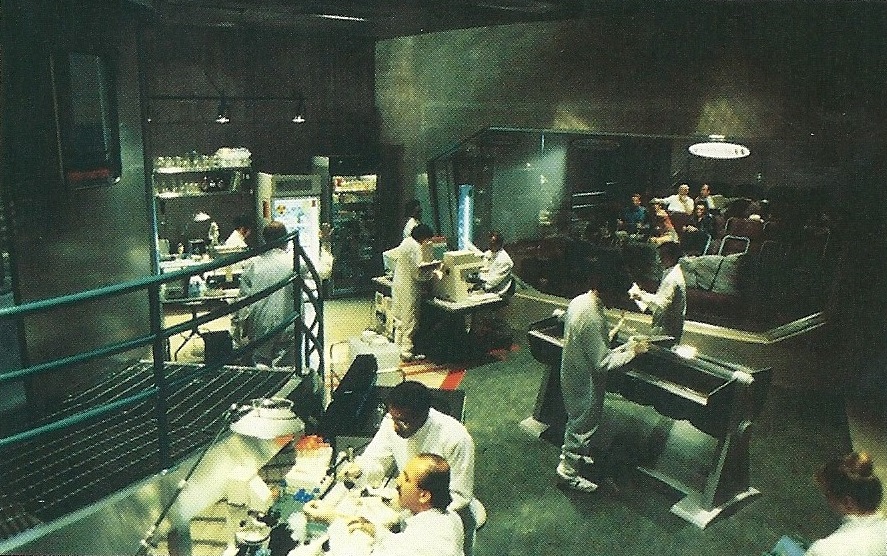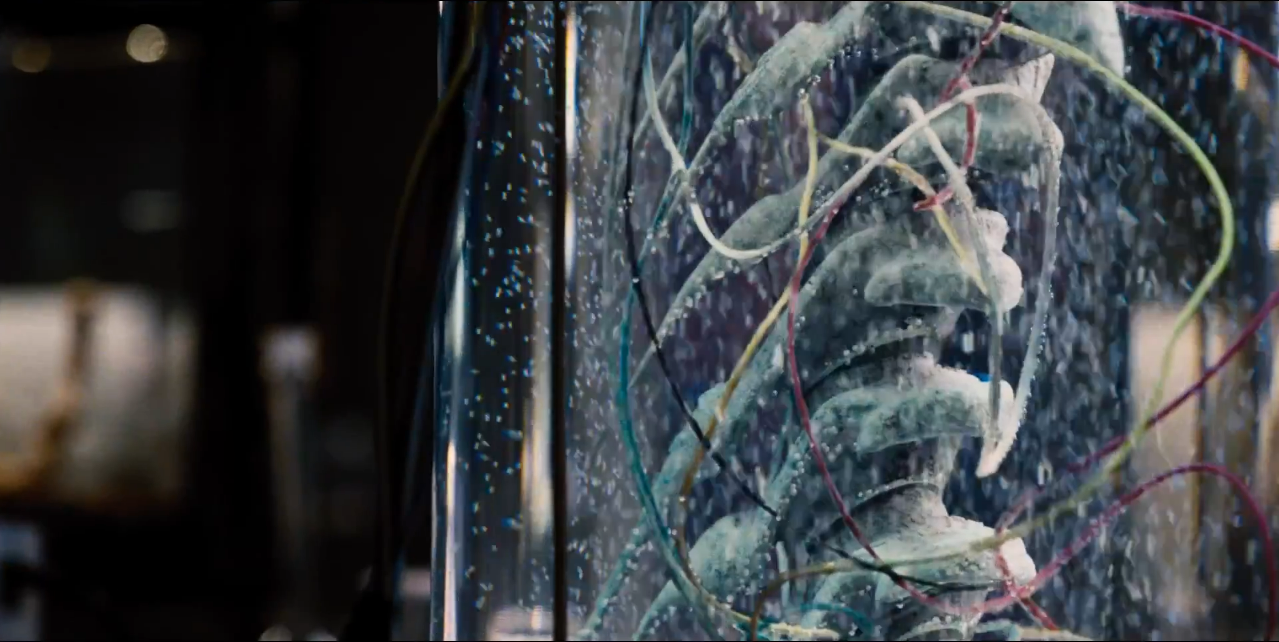Exhibit C - Velociraptor Valley - a detailed look at one of the most intelligent animals to ever walk the Earth.
The attraction will be divided into 6 segments. The theater will rotate around the segments in a counter-clockwise formation similar to the motion of Carousel of Progress at the Walt Disney World Resort.
1 - Introductory Segment
As guests enter the 250 seat rotating theater, they see a dark screen in front of them as they find their seats. As the lights dim, Dr. Henry Wu, Jurassic World's chief geneticist, appears on screen.
(The theaters pan around to reveal another screen with a montage of video which follows Dr. Wu's narration)
Dr. Wu: "Hundreds of millions of years ago, dinosaurs ruled the earth. But they weren't the only creatures that inhabited the earth. Mosquitoes, creatures that feed on the blood of animals, fed on the blood of dinosaurs as well. Often times, tree sap flows over insects and traps them. The sap preserves them like a fossil, something that we call amber, preserving the insects as well as the dinosaur blood. Blood contains billions of strands of DNA, the building blocks of life. Decades ago we uncovered our first ambers, which led us to where we are today, isn't that right Mr. DNA?"
(A cartoon DNA shows up on the screen)
Mr. DNA: "Absolutely Henry! We were lucky that our extraction procedures were able to preserve mostly full paleo-DNA strands...that's the fancy way of saying Dino DNA. Did you know a single strain of DNA contains 3 Billion genetic codes? (A fast moving genetic code image appears on screen) If we looked at screens like these once a second for eight hours a day, it would take us 2 years to look at the entire DNA strand. It's that long!"
Dr. Wu: "Which is why our geneticists have developed efficient extraction techniques over the years, as we will show you how the process has modernized over time."
3 - The Science of Dino DNA
(Theater rotates into a computerized laboratory surrounded by 90s technology, Dr. Wu's narration continues)
Dr. Wu: "Back when InGen was first developing genetic software to encode the extracted dinosaur DNA, it was a long and slow process to get to where we are today. At the time though, these were very fast data networks by Cray XMP supercomputers, creating an incredibly powerful genetic factory for us to use.
We would start by encoded the extracted DNA in the computers. Dino DNA, like humans, is made up of four basic compounds - adenine, cytosine, guanine, and thymine, however much of the DNA extracted was either fragmented or incomplete, so the first thing we had to do is repair it. Here you can see the damage on Gene 1201."
The computer screen in the lab shows the image below:
Paleo-DNA Extraction
1 - GCGTTGCTGG CGTTTTTCCA TAGGCTCCGC CCCCCTGACGT
61 - CGCAACGACC GCAAAAAGGA ATCCGTCCGC GGGGGACTGCA
121 - TGTTCCGACC CTGCCGCTTA CCGGATACCT GTCCGCCTTTT
181 - ACAAGGCTGG GACGGCGAAT GGCCTATGGA CAGGCGGAAAA
301 - GGCCTATCGG CCCCTGCGAA CTTTACGGCAT GGTATTAACGC
721 - CCGGATAGCC GGGGACGCTT GAAATGCCGTA CCATAATTGCG
1201 - ATTAGCCGTT GTGCT****CCTGTCGTTG GGTATTAACGC
Dr. Wu: "From here, we had to cut the DNA at that point, using what are called restriction enzymes, such as SM503, which align the cut fragments with the missing compounds, like so..."
Restriction Enzyme DNA-splicing
1 - GCGTTGCTGGCGTTTTTCCATAGGCTCCGCCCCCCTGACG
61 - CGCAACGACCGCAAAAAGGAATCCGTCCGCGGGGGACTGC
Nsp04
121 - TGTTCCGACCCTGCCGCTTACCGGATACCTGTCCGCCTTTT
181 - ACAAGGCTGGGACGGCGAATGGCCTATGGACAGGCGGAAA
434 DnxT1
301 - GGCCTATCGGCCCCTGCGAACTTTACGGCATGGTATTAACG
721 - CCGGATAGCCGGGGACGCTTGAAATGCCGTACCATAATTGC
SM503
1201 - ATTAGCCGTTGTGCT *AG* CCTGTCGTTGGGTATTAACGCAA
Dr. Wu: "Once the restriction enzymes do their work, our computers would produce the new DNA strand, which we'd then have to combine with other amphibian DNA to make a complete genetic code. It was like putting a puzzle together. And a ton of work. Thankfully at InGen, we are creating the world of tomorrow, today!"(Theater rotates to the next laboratory)
4 - Laboratories at the Park
(As you look in the lab you see AA geneticists in lab coats peering into microscopes, observed data on HD screens, egg stations organized throughout, and a wall of amber fossils to the right hand side.)(On the loud speaker you hear a deep voice give an announcement)
"A reminder - The boats from mainland will be leaving at 1900 hours. All personnel, be at the dock no later than 1845. No exceptions"
The theater comes to a stop, you see a biohazard sign on the left entrance door which reads:
Caution:
Biological Hazard
Teratogenic Substances - Pregnant Women Avoid Exposure to this Area
Danger:
Radioactive Isotopes In Use
Carcinogenic Potential
Dr. Wu: "Don't worry about the signs folks, they are just up for legal purposes. I can assure you everything we do in the InGen labs here at Jurassic World is completely safe. As you can see we have come a long way in a short amount of time. When Masarni Global acquired InGen, it was at a time where people barely even used cell phones. Now you can see the advances in technology upon us. Oh look, I believe we are about to see an egg hatch"
(You see an egg in the center of the lab beginning to move, and the TV monitors on the sides switch to the egg)
Dr. Wu: "This is one of the wonders of our park. There is no unauthorized breeding in Jurassic World. It's one of our security precautions. This is always such a joy to see first hand. It's a Velociraptor as well. Get a good look folks, as we move on to the future of InGen technologies."
5 - The Future of DNA
(As the theater rotates you see another section of the research lab and a montage video of the people working in the labs)
Dr. Wu: "Scientific and technological advancements have accelerated at an astronomical rate, and at InGen, being 'tomorrow, today' could never be more true. With new equipment such as the Hammond XP20, we can now decode hundreds of trillions of paleo-DNA in seconds, and revive extinct animals in merely hours. The days of filling in dino DNA with frog DNA are long in the past. We strive for the future in discovery. With the recent discovery that soft tissue from iron chelators produce more DNA than we ever thought possible, we can put together the genetic puzzle pieces much faster and in more sophisticated ways than ever before.
We are even working on a new project for the park that involves gene splicing and the combination of different dino DNA. While this experiment is still in beta-testing mode, it's just another example of how we are using science to recreate once impossible worlds.
6 - Conclusion and Exit
On behalf of everyone at the John Hammand Center for Paleo-Genetic Research, thank you for exploring our behind-the-scenes look at the creative process behind dino engineering. At the end of the tour, you can exit the theater in to the Hammond Creation Labs, and test out some of our technology for yourselves. Thank you again and enjoy your day here at Jurassic World."
Easter Eggs:
- "Lost World of the Dinosaurs" was the title of Dr. Alan Grant's book in Michael Crichton's novel,Jurassic Park.
- "65 Million Years in the Making" was part of the tagline for the 1993 Jurassic Park film.
- Mr. DNA was an animated figure in the instructional research video in the 1993 film.
- The loud-speaker announcement in the 4th segment is also heard in the same lab setting from the 1993 film.
- The animal bred in the 4th segment is a Velociraptor, a tribute to the "egg hatching" scene from the 1993 film.













